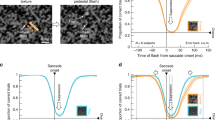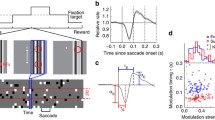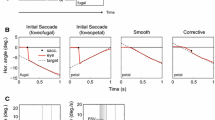Abstract
We investigated how a postsaccadic visual error affects the latency of the subsequent saccade. Observers made sequences of saccades directed to a single object or three separate objects, which could be displaced backward or onward during the primary saccade. The results showed an increase of second saccade latency after a backward displacement and a decrease of second saccade latency after an onward displacement. Moreover, second saccade latencies were particularly short after an onward displacement which resulted in a primary saccade landing position outside the boundary of the objects. We interpret the latency differences in terms of known effects within the saccadic system, specifically the sensitivity to the pattern of visual stimulation, particularly at and near the fovea, and the inverse correlation between secondary saccade amplitudes and secondary saccade latencies.


Similar content being viewed by others
References
Beauvillain C (1999) Change in motor plan with a change in selection of the to-be-recognised object. BBS 22:674–675
Becker W (1972) The control of eye movements in the saccadic system. Bibl Ophthal 82:233–243
Deubel H, Schneider WX, Bridgeman B (1998) Immediate post-saccadic information mediates space constancy. Vision Res 38:3147–3159
Findlay JM, Walker R (1999) A model of saccadic eye movement generation based on parallel processing and competitive inhibition. BBS 22:661–721
Henson DB (1978) Corrective saccades: effects of altering visual feedback. Vision Res 18:63–67
Kingstone A, Klein RM (1993) Visual offset facilitates saccade latency: does pre-disengagement of attention mediate this gap effect? J Exp Psychol Hum Percept Perform 19:251–265
Noto CT, Robinson FR (2001) Visual error is the stimulus for saccade gain adaptation. Cognit Brain Res 12:301–305
Vergilino D, Beauvillain C (2000) The planning of refixation saccades in reading. Vision Res 40:3527–3538
Vergilino D, Beauvillain C (2001) Reference frames in reading: evidence from visually and memory-guided saccades. Vision Res 41:3547–3557
Walker R, Deubel H, Schneider WX, Findlay JM (1997) The effect of remote distractors on saccade programming: evidence for an extended fixation zone. J Neurophysiol 78:1108–1119
Wurtz RH (1996) Vision for the control of movement. The Friedenwald Lecture. Invest Ophthalmol Vis Sci 37:2131–2145
Acknowledgements.
D. Vergilino-Perez was supported by a postdoctoral fellowship from the Fyssen Foundation. We thank Bob Metcalfe for his assistance in programming the experiment. Requests for reprints should be addressed to D. Vergilino-Perez, Laboratoire de Psychologie Expérimentale, UMR 8581 CNRS, Université René Descartes, 71 avenue Edouard Vaillant, 92774 Boulogne Billancourt Cedex, France.
Author information
Authors and Affiliations
Corresponding author
Rights and permissions
About this article
Cite this article
Vergilino-Perez, D., Findlay, J.M. Foveal stimulation and saccadic latencies. Exp Brain Res 150, 255–258 (2003). https://doi.org/10.1007/s00221-003-1418-4
Received:
Accepted:
Published:
Issue Date:
DOI: https://doi.org/10.1007/s00221-003-1418-4




